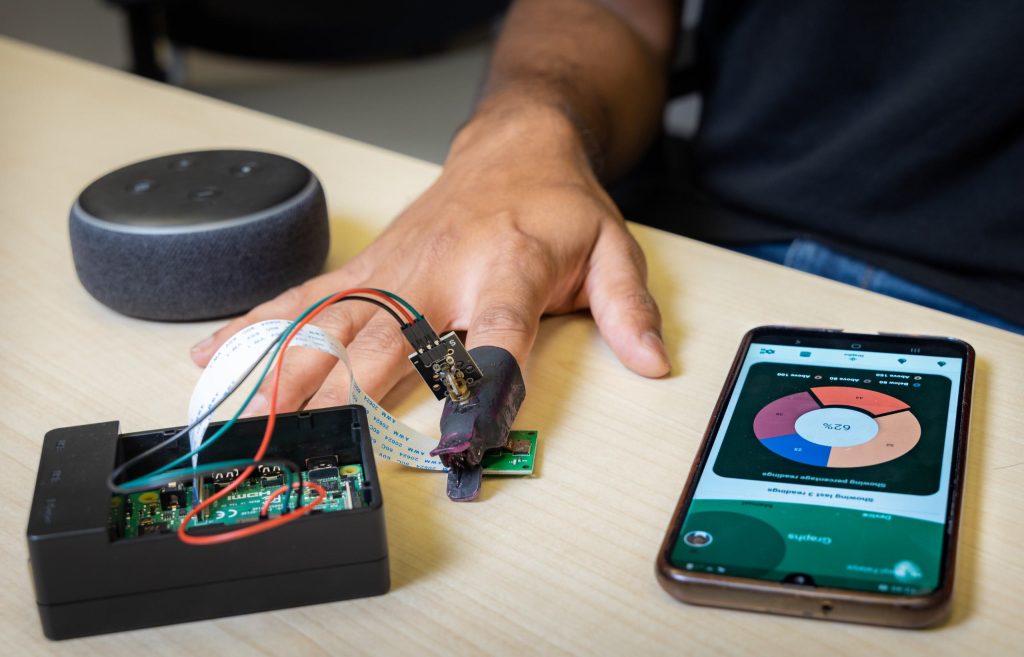Research – GlucoCheck: A non-invasive AI-powered Blood Glucose Monitoring Device
Kennesaw State University – KSU IRB #23-249

The purpose of the study is to test and improve the GlucoCheck noninvasive continuous glucose monitoring system in adults aged 65 years and older. You are invited to be part of this study because your age is 65 years or older. You do not need to have diabetes to participate. We will recruit approximately 40 individuals aged 65 years or older to participate in this study.
If you agree to be in the study, you will be asked to participate in a testing visit at Kennesaw State University, detailed below. You will be asked to fast for 8 hours, or overnight, before your visit. You should drink plenty of water for the two days prior to your visit and consume nothing after midnight before the visit. You are encouraged to bring a water bottle and a snack to your visit, which you will be allowed to eat after your testing is completed. You will be asked to remain in our laboratory for observation for 30 minutes following your testing.
Procedure: Approximately 3 hours
- You will arrive at the KSU Exercise Science Laboratory.
- Your height and weight will be measured.
- Demographic data such as race, gender, and age will be collected.
- We will use sensors to collect skin tone and temperature levels from your finger.
- To collect blood samples, a flexible blood catheter that is inserted in a vein in your arm will be placed by a certified phlebotomist.
- Images from fingers and ears will be collected at 0 min GlucoCheck non-invasive device. Also, blood from a finger prick will be collected at time 0. A blood draw (40mL each) from the catheter will occur at time 0.
- You will complete an oral glucose tolerance test (OGTT) by consuming a 75-gram glucose beverage.
- Images from fingers will be collected at 10-, 20-, 30-, 60-, 90-, and 120 minutes after consuming a 75-gram glucose beverage using GlucoCheck. Also, blood from a finger prick will be collected at times 60- and 120-. Blood draws (40mL each) from the catheter will occur at 10-, 20-, 30-, 60-, 90-, and 120 minutes.
- You will be asked to remain in the laboratory for observation for 30 minutes following your final blood draw.
- You will be asked to use the GlucoCheck mobile app. The following mobile app functions will be tested: “Login,” “Check current and past glucose values,” “Check average glucose value,” “Add a glucose value manually,” “Add food information,” and “View Graphs.”
- You will be asked to fill out a survey regarding the usability of the app.
Clarifications:
The blood samples will be collected using a flexible blood catheter that is inserted into a vein in your arm and serves as a channel for the transport of fluid. The catheter prevents the need to perform multiple needle pricks in your arm. The risks associated with the placement of the catheter are not different than those experienced by a normal blood draw using a needle and syringe. You also have the option to donate your blood sample without the catheter, using a standard blood draw method. All blood draws and catheter placements will be performed by a trained and experienced phlebotomist under sterile conditions.
GlucoCheck measures. During your visit, you will wear a small, non-invasive glucose sensor (GlucoCheck) on your finger or ear. The GlucoCheck uses infrared spectroscopy to measure your glucose levels. The glucose levels collected by these measures will be used to test the accuracy of the GlucoCheck sensor.
**Note: In some people, blood samples are difficult to draw due to poor hydration or other factors. If your blood is unable to be drawn during your visit, the test will be discontinued and you will be rescheduled to re-turn for a repeat glucose tolerance test on another day.**
Investigators:
Dr. Maria Valero (mvalero2@kennesaw.edu) – Principal Investigator
Dr. Katherine Ingram (kingra14@kennesaw.edu) – Co-Principal Investigator
